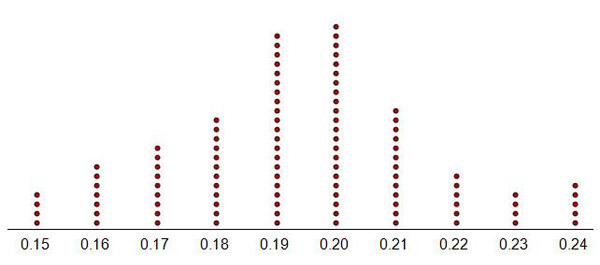Situation Simulated
 Resources for this lesson:
Resources for this lesson:
You will use your Algebra II Journal ![]() on this page.
on this page.
> Glossary ![]()
> Calculator Resources ![]()
> Teacher Resources: Instructional Notes ![]()
Here are the results of 100 simulations. Each dot represents one simulation, and the dots are plotted over the mean that resulted from the simulation.

Probability of a Rain-Out
As you can see, the sample means from the simulations form an approximate normal curve. The mean probability of a rain-out from our simulations is 0.195 with a standard deviation of 0.02.
 Check Your Understanding
Check Your Understanding
 Algebra II Journal: Reflection 5
Algebra II Journal: Reflection 5
Respond to the following reflection questions in your Algebra II Journal ![]() and submit to your teacher.
and submit to your teacher.
A weather reporter states that there is a 50% chance of rain for the next three days.
- Design, but do not conduct, a simulation that will determine the probability that it rains all three days.
- Describe how you would use your simulation tool to form a probability statement with 95% confidence about the chance of it raining all three days. (Do not actually perform these simulations.)
< Previous
> Go to Home Page
> Go to next lesson: The Importance of Being Random


